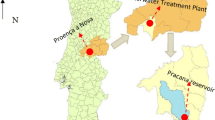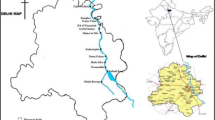Abstract
River water quality management is a tedious job as it comprises multiple variables. The River Yamuna, Delhi’s urban reach, is highly contaminated with very low or zero freshwater flow during the non-monsoon periods. The river quality has been appraised for pre- and post-monsoon periods of 10 years of data collected from the Delhi Pollution Control Council (DPCC). A sharp declination of dissolved oxygen and acceleration of BOD have been observed after the outfalling of drain 1. The wastewater treatment plants data for 2020–2022 have been analyzed, and the removal efficiencies of BOD and COD were found between 65 and 94%. The BIOFORE technology has shown maximum removal efficiencies, around 94% and 89% for BOD and COD, respectively. The level of treatment has been evaluated by developing a water quality model with the existing QUAL2kw framework. Twelve strategies have been generated for four levels of treatment and three different flow conditions. The severely polluted reach of Yamuna has low self-purification capacity; flow augmentation has little effect on the existing load. Hence, the level of treatment required to increase. After the introduction of outfalling drain D13–D16, a sag of DO has been observed; to improve the DO concentration, external aeration is suggested before wastewater disposal into the river. The study is a novel effort to manage the river quality by developing scenarios, including the level of treatments and flow augmentation, and keeping up the desired DO concentration assigned for this river reach.











Similar content being viewed by others
Data availability
Data are available on the domains of Delhi Pollution Control Committee and Central Pollution Control Board, India.
References
Arora, S., & Keshari, A. K. (2021). Pattern recognition of water quality variance in Yamuna River (India) using hierarchical agglomerative cluster and principal component analyses. Environmental Monitoring and Assessment, 193(8). https://doi.org/10.1007/s10661-021-09318-1
Cho, J. H., Seok Sung, K., & Ryong Ha, S. (2004). A river water quality management model for optimising regional wastewater treatment using a genetic algorithm. Journal of Environmental Management, 73(3), 229–242. https://doi.org/10.1016/j.jenvman.2004.07.004
CPCB. (2006). Water quality status of yamuna river, assessment and development of River basin, pp. 1–115. Available from: www.cpcb.nic.in
Darji, J., Lodha, P., & Tyagi, S. (2022). Assimilative capacity and water quality modeling of rivers: A review. Aqua Water Infrastructure, Ecosystems and Society, 71(10), 1127–1147. https://doi.org/10.2166/aqua.2022.063
DPCC. (2020). Water quality of river yamuna during the lockdown background. New Delhi: DPCC.
Fleifle, A., Saavedra, O., Yoshimura, C., Elzeir, M., & Tawfik, A. (2014). Optimization of integrated water quality management for agricultural efficiency and environmental conservation. Environmental Science and Pollution Research, 21(13), 8095–8111. https://doi.org/10.1007/s11356-014-2712-3
Hur, J., Lee, B. M., Lee, T. H., & Park, D. H. (2010). Estimation of biological oxygen demand and chemical oxygen demand for combined sewer systems using synchronous fluorescence spectra. Sensors, 10(4), 2460–2471. https://doi.org/10.3390/s100402460
Jamwal, P., Mittal, A. K., & Mouchel, J. M. (2009). Efficiency evaluation of sewage treatment plants with different technologies in Delhi (India). Environmental Monitoring and Assessment, 153(1–4), 293–305. https://doi.org/10.1007/s10661-008-0356-9
Joshi, P., Chauhan, A., Dua, P., Malik, S., & Liou, Y. A. (2022). Physicochemical and biological analysis of river Yamuna at Palla station from 2009 to 2019. Scientific Reports, 12(1). https://doi.org/10.1038/s41598-022-06900-6
Kang, G., Qiu, Y., Wang, Q., Qi, Z., Sun, Y., & Wang, Y. (2020). Exploration of the critical factors influencing the water quality in two contrasting climatic regions. Environmental Science and Pollution Research, 27(11), 12601–12612. https://doi.org/10.1007/s11356-020-07786-5
Kennel, P. R., Lee, S., Kanel, S. R., Lee, Y.-S., & Ahn, K.-H. (2007). Applying QUAL2Kw for water quality modeling and dissolved oxygen control in the river Bagmati. Environ Monitor Assess, 125, 201–207.
Kumar, B., Singh, U. K., & Ojha, S. N. (2019). Evaluation of geochemical data of Yamuna River using WQI and multivariate statistical analyses: A case study. International Journal of River Basin Management, 17(2), 143–155. https://doi.org/10.1080/15715124.2018.1437743
Lokhande, S., & Tare, V. (2021). Spatio-temporal trends in the flow and water quality: Response of river Yamuna to urbanization. Environmental Monitoring and Assessment, 193(3). https://doi.org/10.1007/s10661-021-08873-x
Moghimi Nezad, S., Ebrahimi, K., & Kerachian, R. (2018). Amirkabir Journal of Civil Engineering investigation of seasonal self-purification variations of Karun River, Iran. Civil Engineering, 49(4), 193–196. https://doi.org/10.22060/ceej.2016.866
Mostafavi, S. A., & Afshar, A. (2011). Waste load allocation using non-dominated archiving multi-colony ant algorithm. Procedia Computer Science, 3, 64–69. https://doi.org/10.1016/j.procs.2010.12.012
Neilson, B. T., Hobson, A. J., VonStackelberg, N., Shupryt, M. & Ostermiller, J. (2013). Using Qual2K modeling to support nutrient criteria -development and wasteload analyses in Utah, Final Project Report. Salt Lake City, UT: Utah Department of Environmental Quality, Division of Water Quality.
NGT. (2014). Restoration and beautification of River Yamuna in NCT of Delhi, Before National Green Tribunal Bench New delhi. Expert-Committee-report-on-flood-plain-restoration-02.08.2014.
Paliwal, R. & Sharma, P. (2007). Application of QUAL2E for the river Yamuna: to assess the impact of pointloads and to recommend measures to improve water quality of the river. Environment, 2702, 1–23.
Parmar, D. L., & Keshari, A. K. (2014a). Wasteload allocation using wastewater treatment and flow augmentation. Environmental Modeling and Assessment, 19(1), 35–44. https://doi.org/10.1007/s10666-013-9378-y
Parmar, D. L., & Keshari, A. K. (2014b). Wasteload allocation using wastewater treatment and flow augmentation. In GIS-coupled numerical modeling for sustainable groundwater development: Case study of Aynalem well field, Ethiopia view project wasteload allocation using wastewater treatment and flow augmentation. Article in Environmental Modeling and Assessment. https://doi.org/10.1007/s10666-013-9378-y
Parween, M., Ramanathan, A., & Raju, N. J. (2017). Waste water management and water quality of river Yamuna in the megacity of Delhi. International journal of Environmental Science and Technology, 14(10), 2109–2124. https://doi.org/10.1007/s13762-017-1280-8
Raeisi, N., Moradi, S., & Scholz, M. (2022). Surface water resources assessment and planning with the QUAL2KW model: A case study of the Maroon and Jarahi Basin (Iran). Water (Switzerland), 14(5). https://doi.org/10.3390/w14050705
Ravindra, K., Meenakshi, A., Rani, M., & Kaushik, A. (2003). Seasonal variations in physico-chemical characteristics of River Yamuna in Haryana and its ecological best-designated use. Journal of Environmental Monitoring, 5(3), 419–426. https://doi.org/10.1039/b301723k
Sewage Treatment Plant Inventory. (2021). National inventory of sewage treatment plants central pollution control board. Parivesh Bhawan, East Arjun Nagar, Delhi.
Sharma, D., Kansal, A., & Pelletier, G. (2017). Water quality modeling for urban reach of Yamuna river, India (1999–2009), using QUAL2Kw. Applied Water Science, 7(3), 1535–1559. https://doi.org/10.1007/s13201-015-0311-1
Sharma, P., Sood, S., & Mishra, S. K. (2020). Development of multiple linear regression model for biochemical oxygen demand (BOD) removal efficiency of different sewage treatment technologies in Delhi, India. Sustainable. Water Resources Management, 6(2). https://doi.org/10.1007/s40899-020-00377-9
Vega, M., Pardo, R., Barrado, E., & Debán, L. (1998). Assessment of seasonal and polluting effects on the quality of river water by exploratory data analysis. Water Research, 32(12), 3581–3592. https://doi.org/10.1016/S0043-1354(98)00138-9
Verma, N., Singh, G., & Ahsan, N. (2022). Development of water quality management strategies for an urban river reach: A case study of the river Yamuna, Delhi, India. Arabian Journal of Geosciences, 15(24). https://doi.org/10.1007/s12517-022-11030-4
Verma, N., Singh, G., & Ahsan, N. (2023a). Assessment of spatiotemporal variations in water quality of the urban river reach, Yamuna, Delhi. Water, Air, and Soil Pollution, 234(9). https://doi.org/10.1007/s11270-023-06569-1
Verma, N., Singh, G., & Ahsan, N. (2023b). Water quality management by enhancing assimilation capacity with flow augmentation: A case study for the Yamuna River, Delhi. Water Science & Technology, 88(7), 1821–1832. https://doi.org/10.2166/wst.2023.302
Yamuna Monitoring report (2020) Report on water quality of river Yamuna during the lockdown background Yamuna. Office of the Yamuna Pollution Monitoring Committee appointed by Hon'ble NGT room no. 58, India International Centre 40, Max Mueller Marg, Lodhi Estate New, T. H. E., Monitoring, P., Marg, M. A. X. M., & Estate, L. (2020). Dated: 21.04.2020. 58, 1–32.
Yang, L., Wei, J., Qi, J., & Zhang, M. (2022). Effect of sewage treatment plant effluent on water quality of Zhangze reservoir based on EFDC model. Frontiers in Environmental Science, 10. https://doi.org/10.3389/fenvs.2022.874502
Yassuda, E. A., Davie, S. R., Mendelsohn, D. L., Isaji, T., & Peene, S. J. (2000). Article No. ecss. In Estuarine, Coastal and Shelf Science (Vol. 50). http://www.idealibrary.comon
Zare Farjoudi, S., Moridi, A., & Sarang, A. (2021). Multi-objective waste load allocation in river system under inflow uncertainty. International journal of Environmental Science and Technology, 18(6), 1549–1560. https://doi.org/10.1007/s13762-020-02897-5
Zolfagharipoor, M. A., & Ahmadi, A. (2017). Effluent trading in river systems through stochastic decision-making process: A case study. Environmental Science and Pollution Research, 24(25), 20655–20672. https://doi.org/10.1007/s11356-017-9720-z
Acknowledgements
The authors are also grateful to reviewers for giving valuable time and comments to improve the quality of the study.
Author information
Authors and Affiliations
Contributions
Nibedita Verma has completed the research work under the supervision of Dr. Geeta Singh and Prof. Naved Ahsan. Nibedita Verma prepared the manuscript. Dr. Geeta Singh and Prof. Naved Ahsan reviewed the manuscript. All authors read and approved the final manuscript.
Corresponding author
Ethics declarations
Ethics approval
NA.
Consent to participate
NA.
Consent for publication
The authors declare that the work has not been published before in any form and is not under consideration by another publisher, that the persons listed above are in the proper order, and that no author entitled to credit has been omitted.
Competing interests
The authors declare no competing interests.
Additional information
Publisher’s note
Springer Nature remains neutral with regard to jurisdictional claims in published maps and institutional affiliations.
Rights and permissions
Springer Nature or its licensor (e.g. a society or other partner) holds exclusive rights to this article under a publishing agreement with the author(s) or other rightsholder(s); author self-archiving of the accepted manuscript version of this article is solely governed by the terms of such publishing agreement and applicable law.
About this article
Cite this article
Verma, N., Singh, G. & Ahsan, N. Water quality modeling-based assessment for the scope of wastewater treatment of the urban reach of River Yamuna at Delhi, India. Environ Monit Assess 196, 155 (2024). https://doi.org/10.1007/s10661-024-12315-9
Received:
Accepted:
Published:
DOI: https://doi.org/10.1007/s10661-024-12315-9




